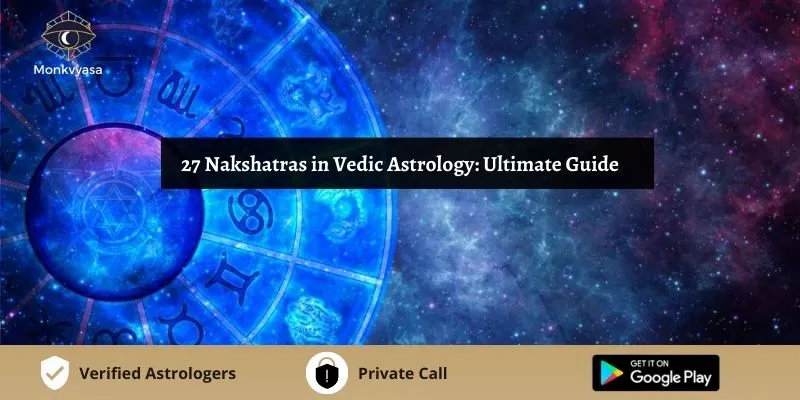

Nakshatras have an important place in Vedic astrology. The word Nakshatra is derived from the Sanskrit words "naksha", meaning map, and "tara", meaning star. Therefore, the full meaning of the word Nakshatra is the map of the stars. The earliest mention of constellations can be found in the Rigveda, and a complete list of the 27 constellations is recorded in the Yajurveda and the Atharvaveda.
According to Vedic astrology, Nakshatras are related to Moon's birth signs, and Moon is considered the ruler of Nakshatras. The Moon's movement through the zodiac, moving through each zodiac sign for 28 days and staying in each zodiac sign for 2.3 days, has a profound effect on a person's life and is taken into account in astrological predictions.
How to Identify Your Nakshatra
To determine your respective Nakshatra, it is important to have accurate birth information, including the exact date, year, place, and time of birth. An astrologer can then easily calculate the position of the Moon at the time of birth and the Nakshatra can determine.
Your Nakshatra is determined by the position of the Moon at the time of your birth. In addition, your horoscope provides valuable insight into your personality, health, and other aspects of your life through the positions of the Sun and Moon at the time of your birth. Therefore, it is important to consider your horoscope when discovering your Nakshatra and its effects on your life.
The 27 Nakshatras in Vedic astrology
- Ashwini
- Bharani
- Krittika
- Rohini
- Mrigashirsha
- Ardra
- Punarvasu
- Pushya
- Ashlesha
- Magha
- Purva Phalguni
- Uttara Phalguni
- Hasta
- Chitra
- Swati
- Vishakha
- Anuradha
- Jyeshtha
- Mula
- Purva Ashadha
- Uttara Ashadha
- Shravana
- Dhanishtha
- Shatabhishav
- Purva Bhadrapada
- Uttara Bhadrapada
- Revati
These Nakshatras are used in Vedic astrology to gain insight into an individual's personality traits, relationships, career, health, and more.
Also Read: Difference Between Vedic Astrology And Tarot Card Readings Crystals For Your Zodiac Signs.
The mythological tale behind the Nakshatras
According to Hindu mythology, King Dakshana had 27 daughters whom Chandrama married. However, Moon strongly preferred one of his wives, Rohini, which led the other 26 wives to complain to the king.
Despite the king's request, the moon did not change its ways, and this enraged the king, resulting in a curse that caused the moon to shrink in size and become emaciated. The other gods then asked the king to lift the curse and promised that Moon would spend equal time with all his wives.
Importance of Nakshatra in astrology
The study of Nakshatras in Vedic astrology holds great significance. It is often used to understand an individual's thought process, perception of life, and mental disposition. Additionally, astrologers can determine the Dasha period in a person's horoscope by analyzing the Nakshatras.
- The analysis of constellations is very important in astrology. They play a vital role in determining a person's personality traits, thoughts and perception towards life.
- In addition to this, Nakshatras are also used to determine the dasha period in a person's horoscope.
- Each Nakshatra in astrology has its own unique energy and power, which is ruled by a different ruling deity. They are considered to be the home of our karmas, which reflect the results of our past actions.
- In astrological predictions, constellations are widely used to understand a person's personality, aspirations, and energy levels.
- Nakshatras also play an important role in determining compatibility between couples during horoscope matching.
- By taking into account the Nakshatras, astrologers can predict the compatibility and level of prosperity in the future married life of the couple.
Difference between Nakshatras and Zodiac Signs
The sky can be divided into twelve equal parts, which are called zodiac signs. But if the sky is divided into 27 parts, each part is called a Nakshatra. In the 360° zodiac, each zodiac sign covers an area of 30°. On the other hand, each Nakshatra covers approximately 13.33°.
Therefore, in sidereal astrology, there is a subtle division of the twelve signs. In other words, each zodiac sign, from Aries to Pisces, is roughly 2.25 of a nakshatra.
Conclusion:
Lastly, the 27 Nakshatras play an important role in Vedic astrology and are considered the building blocks of a person's astrological chart. Each Nakshatra has its unique set of qualities and characteristics that influence a person's personality, strengths, weaknesses and life events. By considering the position of the Moon at the time of birth, astrologers can gain a deeper understanding of a person's fate and destiny. The study of constellations is an important aspect of Vedic astrology and provides a broad framework for understanding the influence of celestial bodies on human life. For more consult our certified Astrologers.
Follow us on Instagram and Youtube for more Astrological videos.




 Call Now !
Call Now !



